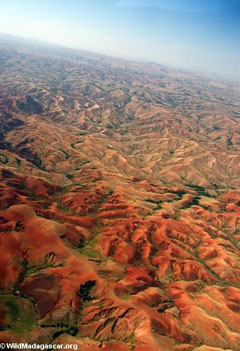Madagascar’s deforestation rate drops 8-fold in parks
Madagascar’s deforestation rate drops 8-fold in parks
mongabay.com
March 10, 2008
Madagascar’s deforestation rate in protected areas has fallen by eight-fold since the 1990s according to Conservation International and the Malagasy government.
Reuters reports that satellite images reveal a drop in deforestation rate in reserves from 0.8 percent per year in the 1990s to 0.1 percent today.
Island-wide, Madagascar’s deforestation rate is 0.3 percent, down from 0.5 percent during the 1990s, according to the U.N. Since 1990 Madagascar has lost about 6.3 percent of its forest cover. Most forest clearing results from charcoal production and subsistence agriculture.
 Deforestation in Madagascar. |
“We need to do a lot. But the important thing is that the trend is in the right direction, which is not the case for every country in the world,” Reuters quoted Conservation International’s James MacKinnon as saying.
An island about the size of California located off the eastern coast of southern Africa, Madagascar is famous for its biodiversity including more than 70 types of lemurs, brightly colored chameleons and toxic frogs, the puma-like fossa, and hedgehog-like tenrecs. With three-quarters of its species found nowhere else on Earth, conservationists have made the island a top conservation priority.
In 2003, Madagascar’s President Marc Ravalomanana announced plans to set aside 10 percent — 6 million hectares (15 million acres) — of the country’s land area as protected areas. Since then tens of millions of dollars have flowed into the country for setting up parks and establishing sustainable development initiatives.
Related
Real-time satellite tracking of fires in Madagascar could help protect lemurs, forests October 29, 2007
Every year as much as one-third of Madagascar, one of the planet’s most biodiverse islands, goes up in flames. Now a new tool gives scientists the ability to monitor and track Madagascar’s fires in real-time through the Internet. Madagascar is world-famous for its lemurs, a diverse group of primates that are endemic to the Indian Ocean island nation. Madagascar is also known for widespread bush fires that are usually set by farmers and cattle herders seeking to clear land for subsistence agriculture or promote the growth of new vegetation for animal fodder. These fires sometimes escape scrub areas and spread into parks and endangered forest areas.
Madagascar increases fines for forest burning January 3, 2008
Madagascar will increase penalties for people caught setting land-clearing fires on the biodiverse island, according to a report from Deutsche Presse-Agentur. Thursday Environment Minister Harison Randriarimanana announced new fines for farmers practicing “tavy”, as slash-and-burn agriculture is known in Madagascar, and unveiled plans to educate the country’s mayors about the environmental impact of bush fires, which burn across as much as one-third of the country each year. He also said that reforestation efforts by individual Malagasy, as the people of Madagascar are known, could reforest 100,000 hectares of land with 200 million trees.